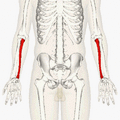Ulna facts for kids
The ulna is one of the two main bones found in your lower arm, also called the forearm. It works with the other bone, the radius, to help you move your hand and arm. Above these bones is your elbow and the humerus bone in your upper arm. Below them are the many small bones of your hand.
Contents
What is the Ulna Bone?
The ulna is a long bone that runs from your elbow down to your wrist on the side of your little finger. It's an important part of your arm's structure and helps with many movements.
Where is the Ulna Located?
The ulna is found in the forearm, which is the part of your arm between your elbow and your wrist. It's on the medial side, meaning it's closer to your body's midline when your arm is at your side. The radius bone is on the lateral side, closer to your thumb.
What Does the Ulna Do?
The ulna has several key jobs:
- Supports your forearm: It provides a strong framework for your lower arm.
- Helps with movement: It works with the radius to allow you to twist your forearm, like when you turn a doorknob. This movement is called pronation and supination.
- Connects to the elbow: The top part of the ulna forms a major part of your elbow joint, allowing your arm to bend and straighten.
- Connects to the wrist: The bottom part of the ulna connects to your wrist, helping with hand movements.
How Does the Ulna Work with Other Bones?
The ulna doesn't work alone! It connects with several other bones to allow for a wide range of arm and hand movements.
The Ulna and the Humerus
At your elbow, the top end of the ulna fits perfectly with the bottom end of the humerus (your upper arm bone). This connection forms a hinge joint, which is like the hinge on a door. It lets you bend and straighten your arm.
The Ulna and the Radius
The ulna and the radius run parallel to each other in your forearm. They are connected by a strong tissue called the interosseous membrane. This connection allows them to rotate around each other, which is how you can turn your palm up or down.
The Ulna and the Wrist Bones
At your wrist, the ulna connects with some of the small bones of your hand, called the carpal bones. While the radius is the main bone connecting to the wrist, the ulna still plays a role in wrist stability and movement.
Common Injuries to the Ulna
Like any bone, the ulna can sometimes get injured.
- Fractures: A fracture means the bone is broken. Ulna fractures can happen from falls, sports injuries, or direct impacts.
- Dislocations: Sometimes, the ulna can move out of its normal position at the elbow or wrist joint. This is called a dislocation.
If you ever feel severe pain or can't move your arm properly after an injury, it's important to tell an adult right away so you can see a doctor.
Images for kids
See also
 In Spanish: Cúbito para niños
In Spanish: Cúbito para niños









